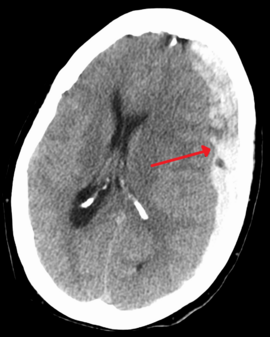
Back ورم دموي تحت الجافية Arabic Subdural hematoma Azerbaijani সাবডুরাল হেমাটোমা Bengali/Bangla Hematoma subdural Catalan Subdurální hematom Czech Subduralt hæmatom Danish Υποσκληρίδιο αιμάτωμα Greek Hematoma subdural Spanish هماتوم سابدورال Persian Kovakalvonalainen verenvuoto Finnish
| Subdural hematoma | |
|---|---|
| Other names | Subdural haematoma, subdural haemorrhage |
 | |
| Subdural hematoma as marked by the arrow with significant midline shift | |
| Specialty | Neurosurgery, Neurology |
| Causes | Head injury, alcoholism, reduction in cerebrospinal fluid pressure[1][2] |
| Risk factors | Senescence, long-term excessive alcohol consumption, dementia, and cerebrospinal fluid leak[3][4] |
A subdural hematoma (SDH) is a type of bleeding in which a collection of blood—usually but not always associated with a traumatic brain injury—gathers between the inner layer of the dura mater and the arachnoid mater of the meninges surrounding the brain. It usually results from tears in bridging veins that cross the subdural space.
Subdural hematomas may cause an increase in the pressure inside the skull, which in turn can cause compression of and damage to delicate brain tissue. Acute subdural hematomas are often life-threatening. Chronic subdural hematomas have a better prognosis if properly managed.
In contrast, epidural hematomas are usually caused by tears in arteries, resulting in a build-up of blood between the dura mater and the skull. The third type of brain hemorrhage, known as a subarachnoid hemorrhage (SAH), causes bleeding into the subarachnoid space between the arachnoid mater and the pia mater. SAH are often seen in trauma settings, or after rupture of intracranial aneurysms.[citation needed]
- ^ Cite error: The named reference
:0was invoked but never defined (see the help page). - ^ Cite error: The named reference
UVTwas invoked but never defined (see the help page). - ^ Cite error: The named reference
wagnerwas invoked but never defined (see the help page). - ^ Cite error: The named reference
:2was invoked but never defined (see the help page).
© MMXXIII Rich X Search. We shall prevail. All rights reserved. Rich X Search